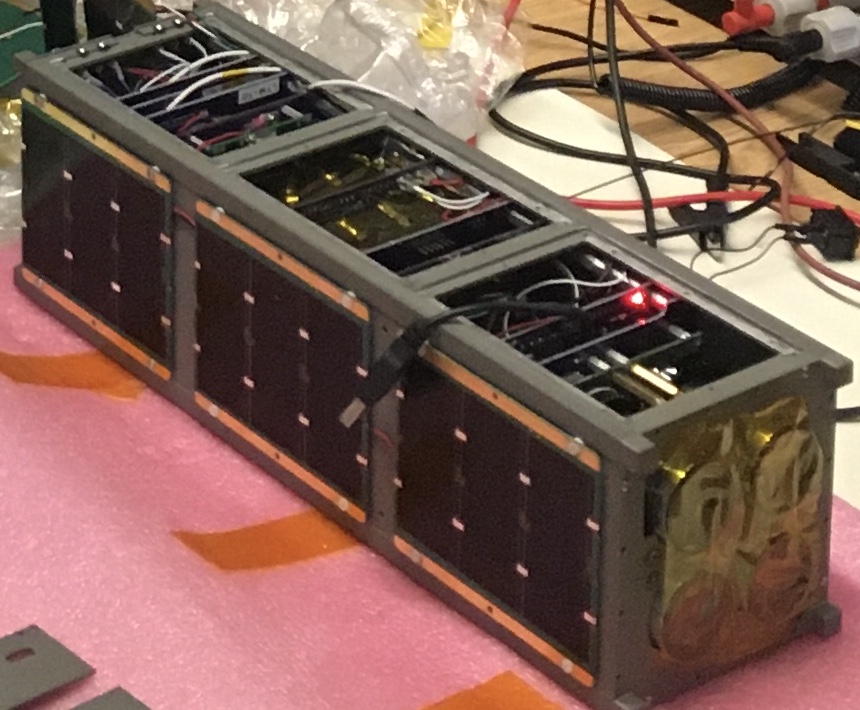
Reposted from ANS-303:
MESAT-1 to Carry AMSAT Linear Transponder Module
An AMSAT-constructed linear transponder module is included in the MESAT 3U satellite to be deployed as part of NASA’s upcoming ELaNa 43 mission.
MESAT-1 is a stack of three tech-stuffed 4-inch cubes assembled at the University of Maine and destined for space in 2022. The first satellite of its kind ever built in Maine, MESAT-1 carries three imaging experiments proposed by Maine schools and a 2-way radio for use by ground control and amateur radio enthusiasts.
MESAT-1 was originally projected to launch from Vandenberg Space Force Base, California, in June 2022, but has been delayed. The satellite will be carried by a Firefly Aerospace “Alpha” rocket and released into a Sun-synchronous orbit about 555 kilometers (350 miles) above Earth. It will fly nearly over the poles traveling at about 7.8 kilometers per second (17,000 mph), making a full orbit in roughly 100 minutes. Any given location on Earth will experience 4 to 6 passes per day, with each pass lasting less than 15 minutes. MESAT-1 is expected to remain in space for well over a decade.
A statewide competition in 2019 drew payload proposals from schools across Maine. Three projects were selected for the MESAT-1 mission: ALBEDO, IMAGER, and HAB.
ALBEDO: Saco Middle School will study reflected light (albedo) and local temperature in urban and rural areas, with the idea that urban heat islands could be mitigated through architectural designs that reflect more light.
IMAGER: Fryeburg Academy will photograph shallow coastal waters as part of an effort to distinguish turbidity and phytoplankton concentration from space. The academy is collaborating with the Wells National Estuarine Research Reserve.
HAB: Falmouth High School will work on early detection of harmful algal blooms by measuring atmospheric temperature and water vapor levels around bloom areas. They will watch blooms develop, move, and disperse.
The main radio aboard MESAT-1 is a linear transponder module (LTM-1) built by the nonprofit Radio Amateur Satellite Corporation (AMSAT), a partner in the project. The ground station operator will command the satellite through LTM-1 and the module will transmit telemetry back to Earth. LTM-1 will also be made available to amateur radio operators for 2-way communication.
UMaine applied to the International Amateur Radio Union to coordinate its planned frequency use for MESAT-1. The IARU approved this plan on 22 November 2021:
Telemetry beacon downlink: 435.800 MHz 1200 baud BPSK
Transponder uplink: 145.910-145.940 MHz
Transponder downlink: 435.810-435.840 MHz
MESAT-1 carries a second radio, an EyeStar transmitter, originally intended to interface with the satellite’s built-in GPS and the GlobalStar network to provide the ground team with accurate, hourly position information. This aspect of the mission was altered during MESAT-1 construction. The EyeStar unit will serve only a minimal function on MESAT-1.
Background on Maine’s First CubeSat
MESAT-1 exists thanks to NASA’s CubeSat Launch Initiative (CSLI) and the Maine Space Grant Consortium. Through CSLI, NASA has selected more than 200 CubeSat missions for the Educational Launch of Nanosatellites program. More than 130 ELaNA satellites have been launched at NASA’s expense since 2011.
In 2018, Maine Space Grant kicked off a pilot Maine CubeSat Launch Initiative to involve students and teachers from across the state in designing CubeSat missions. Through a competitive process, the consortium selected three experiments to propose for NASA’s 2019 ELaNa opportunity.
The MESAT-1 proposal was accepted by NASA early in 2020. The satellite was paired with launch provider Firefly Aerospace for ELaNa mission 43.
Dr. Ali Abedi, director of the WiSe-Net Lab at UMaine Orono, assigned three UMaine graduate students the task of producing the satellite. With the support of the Maine Space Grant Consortium, they completed MESAT-1 in time for a 2022 launch.
[ANS thanks mainesat.org for the above information]
